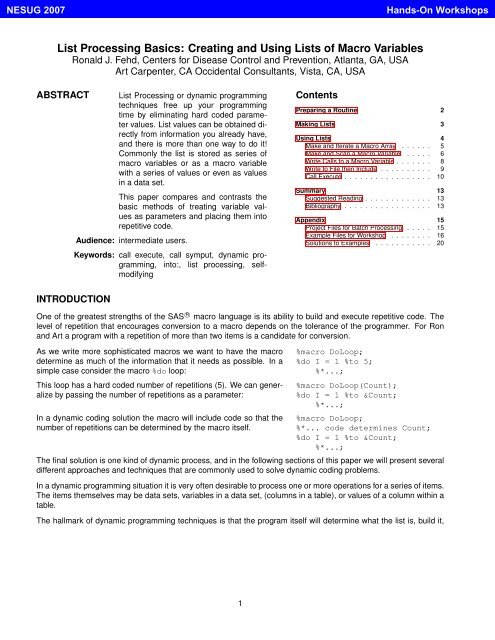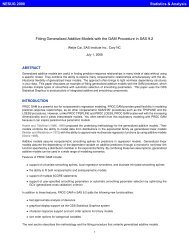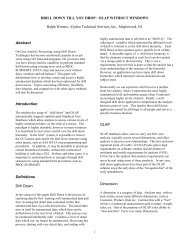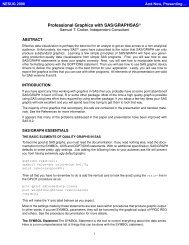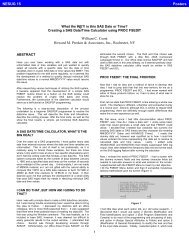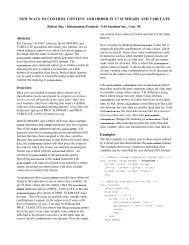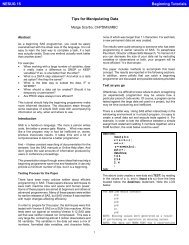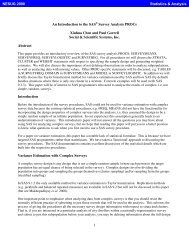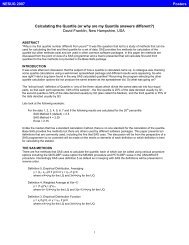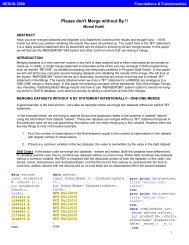List Processing Basics: Creating and Using Lists of Macro ... - NESUG
List Processing Basics: Creating and Using Lists of Macro ... - NESUG
List Processing Basics: Creating and Using Lists of Macro ... - NESUG
Create successful ePaper yourself
Turn your PDF publications into a flip-book with our unique Google optimized e-Paper software.
<strong>NESUG</strong> 2007H<strong>and</strong>s-On Workshops<strong>List</strong> <strong>Processing</strong> <strong>Basics</strong>: <strong>Creating</strong> <strong>and</strong> <strong>Using</strong> <strong>List</strong>s <strong>of</strong> <strong>Macro</strong> VariablesRonald J. Fehd, Centers for Disease Control <strong>and</strong> Prevention, Atlanta, GA, USAArt Carpenter, CA Occidental Consultants, Vista, CA, USAABSTRACT<strong>List</strong> <strong>Processing</strong> or dynamic programmingtechniques free up your programmingtime by eliminating hard coded parametervalues. <strong>List</strong> values can be obtained directlyfrom information you already have,<strong>and</strong> there is more than one way to do it!Commonly the list is stored as series <strong>of</strong>macro variables or as a macro variablewith a series <strong>of</strong> values or even as valuesin a data set.This paper compares <strong>and</strong> contrasts thebasic methods <strong>of</strong> treating variable valuesas parameters <strong>and</strong> placing them intorepetitive code.Audience: intermediate users.Keywords: call execute, call symput, dynamic programming,into:, list processing, selfmodifyingContentsPreparing a Routine 2Making <strong>List</strong>s 3<strong>Using</strong> <strong>List</strong>s 4Make <strong>and</strong> Iterate a <strong>Macro</strong> Array . . . . . . 5Make <strong>and</strong> Scan a <strong>Macro</strong> Variable . . . . . 6Write Calls to a <strong>Macro</strong> Variable . . . . . . . 8Write to File then Include . . . . . . . . . . 9Call Execute . . . . . . . . . . . . . . . . . 10Summary 13Suggested Reading . . . . . . . . . . . . . 13Bibliography . . . . . . . . . . . . . . . . . 13Appendix 15Project Files for Batch <strong>Processing</strong> . . . . . 15Example Files for Workshop . . . . . . . . 16Solutions to Examples . . . . . . . . . . . 20INTRODUCTIONOne <strong>of</strong> the greatest strengths <strong>of</strong> the SAS R○ macro language is its ability to build <strong>and</strong> execute repetitive code. Thelevel <strong>of</strong> repetition that encourages conversion to a macro depends on the tolerance <strong>of</strong> the programmer. For Ron<strong>and</strong> Art a program with a repetition <strong>of</strong> more than two items is a c<strong>and</strong>idate for conversion.As we write more sophisticated macros we want to have the macrodetermine as much <strong>of</strong> the information that it needs as possible. In asimple case consider the macro %do loop:This loop has a hard coded number <strong>of</strong> repetitions (5). We can generalizeby passing the number <strong>of</strong> repetitions as a parameter:In a dynamic coding solution the macro will include code so that thenumber <strong>of</strong> repetitions can be determined by the macro itself.%macro DoLoop;%do I = 1 %to 5;%*...;%macro DoLoop(Count);%do I = 1 %to &Count;%*...;%macro DoLoop;%*... code determines Count;%do I = 1 %to &Count;%*...;The final solution is one kind <strong>of</strong> dynamic process, <strong>and</strong> in the following sections <strong>of</strong> this paper we will present severaldifferent approaches <strong>and</strong> techniques that are commonly used to solve dynamic coding problems.In a dynamic programming situation it is very <strong>of</strong>ten desirable to process one or more operations for a series <strong>of</strong> items.The items themselves may be data sets, variables in a data set, (columns in a table), or values <strong>of</strong> a column within atable.The hallmark <strong>of</strong> dynamic programming techniques is that the program itself will determine what the list is, build it,1
<strong>NESUG</strong> 2007H<strong>and</strong>s-On Workshops<strong>and</strong> then use it. In a dynamic program all this is done without programmer intervention.Consider the following simple ProcReport step which routes the output toan html file.See Ex01, pg. 16.Report-Africa.sas1 ods html file = "&path.Africa.html"2 style = journal;34 Title "Sales in Africa";56 PROC Report data = sashelp.Shoes7 nowindows;8 where region = ’Africa’;9 column product subsidiary, sales;10 define product / group;11 define subsidiary / across;12 define sales / analysis ’’;13 run;14 ods html close;If we want a similar report for each region we cannot simply use a by statement in the PROC step because we wantthe Title <strong>and</strong> the html filename to contain the name <strong>of</strong> the region. Hard coding the value <strong>of</strong> one region whiletesting is no problem, for two it is irritating, for three it is time to find a better solution. We need a dynamic solutionthat can determine the number <strong>of</strong> regions, the values <strong>of</strong> each, <strong>and</strong> then execute this step for each one.In the following sections we examine this problem from several angles<strong>and</strong> we show several different techniques that can be used to build theability to provide the needed repetition.The examples show the concepts <strong>of</strong> testing the routine as it is beingdeveloped.• prepare routine– identify program parameter(s)– convert program to routine• make list <strong>of</strong> parameter values• iterate with each value: call routinePREPARING A ROUTINEIDENTIFY PROGRAM PARAMETERSOur report has three occurences <strong>of</strong> the string Africa. This is the firstvalue <strong>of</strong> the variable Region in the data set sashelp.Shoes.See Ex01, pg. 16.1 ... file = ’Africa.html’2 Title ’Sales in Africa’;3 where Region = ’Africa’;CONVERT TO ROUTINEThe first step in converting our program to a routine is to keep theprogram running by making it into a parameterized include file. Addone macro variable for each parameter <strong>and</strong> replace the occurences <strong>of</strong>each parameter value with the macro variable.Find <strong>and</strong> replace the three occurences <strong>of</strong> the string Africa with themacro variable reference &Region.. Note that the prefix to the macrovariable reference is the special character ampers<strong>and</strong> (&) <strong>and</strong> the suffixis the character dot (.). In the filename-extension the first dot endsthe macro variable reference <strong>and</strong> the second dot separates the filename<strong>and</strong> the extension.1 %Let Region=Africa;2 ... file = "&Region..html"3 Title "Sales in &Region.";4 where Region = "&Region.";2
<strong>NESUG</strong> 2007H<strong>and</strong>s-On WorkshopsCONVERT TO MACROFinally change the allocation <strong>of</strong> the macro variablefrom %Let to %macro parameter. 1 %macro Report( Region=Africa);2 ... file = "&Region..html"3 Title "Sales in &Region.";4 where Region = "&Region.";The next task is to identify the list <strong>of</strong> parametervalues <strong>and</strong> decide how best togenerate the macro calls shown here inthe test section at the bottom <strong>of</strong> the program.Note lines 5–9: Since one value containsa slash (/) we create a newvariable Filename <strong>and</strong> change theslash to a hyphen to avoid an operatingsystem clash <strong>of</strong> folder CentralAmerica/Caribbean not existing.Task: How to generate these macro calls?Report-Region-macro.sas28 %Report(Region = Africa);29 %Report(Region = Asia );30 %Report(Region31 = Central America/Caribbean);See Ex00, pg. 16.To speed up our testing, we write a verysimple test macro which only lists its parametervalues.Report-Region-macro.sas1 %<strong>Macro</strong> Report(InData = sashelp.Shoes2 ,Region =3 ,OutPath = /*here: same folder*/4 );5 %local Filename; %Let Filename = &Region.;6 %** change slash to hypen in7 Central America/Caribbean;8 %If %index(&Region,/) %then %Let Filename =9 %sysfunc(translate(&Region.,-,/));1011 ods html file = "&OutPath.&Filename..html"12 style = journal;1314 Title "Sales in &Region.";1516 PROC Report data = &InData.17 nowindows;18 where Region = "&Region.";19 column Product Subsidiary, Sales;20 define Product / group;21 define Subsidiary / across;22 define Sales / analysis ’’;23 run;24 ods html close;25 run; %mend Report;ReportTest.sas1 %<strong>Macro</strong> ReportTest(Region = );2 %put _local_;3 run; %Mend;MAKING LISTSWHAT IS A LIST?In conversation we use the word list to mean any collection <strong>of</strong> items,however they may be related. An example would be a todo or shoppinglist. The items in the list share a common property: tasks to bedone, items to purchase. In a formal language, such as set theory,a list is defined as an unordered set. In the SAS language a list isa table. For our discussion here, the list is a collection <strong>of</strong> the uniquevalues <strong>of</strong> the variable region <strong>of</strong> the table sashelp.shoes.Definition <strong>of</strong> <strong>List</strong>1. natural language: list contains items2. formal language: an unordered set3. SAS: data set or tableWHERE ARE LISTS?SAS provides many unique data sets in either sashelp views or sqldictionary tables. DiIorio <strong>and</strong> Abolafia [5, sugi29.237] provide a comparision<strong>of</strong> sashelp views <strong>and</strong> sql dictionary tables <strong>and</strong> a dozen examples.Most summarization procedures — freq <strong>and</strong> means/summary— can produce an output data set which contains a unique list <strong>of</strong> variablevalues. Fehd [8, pnwsug2006.012] provides usage examples <strong>of</strong>the more common sql dictionary tables.Sources <strong>of</strong> <strong>List</strong>s1. sashelp views2. sql dictionary tables3. summarization procedure output3
<strong>NESUG</strong> 2007H<strong>and</strong>s-On WorkshopsMAKING UNIQUE LISTS FROM DATAFor this reporting example considerthese methods to extract aunique list <strong>of</strong> parameter valuesfrom a data set. Each method producesa data set, Regions, with alist <strong>of</strong> unique values <strong>of</strong> the variableRegion. We use this list to writethe calls to the macro Report.See Ex00: review pg. 16 or Ex02:symputx, pg. 16.• proc sort• proc sqlmake-unique-sort.sas1 PROC Sort data = sashelp.Shoes2 (keep = Region)3 out = Regions4 nodupkey;5 by Region;make-unique-sql-create.sas1 PROC SQL; create table Regions as2 select distinct Region3 from sashelp.Shoes;4 quit;USING LISTSHaving obtained a list <strong>of</strong> unique values ina table, we next need to convert the liststored in the table to a list available in themacro environment. Then we can generatethe series <strong>of</strong> macro calls from this list.Consider the following methods to generatethese calls to the macro Report:• make table into macro array, using either:1. symputx Ex02, pg. 162. sql into Ex03, pg. 16then call in macro %do loop: . . . . . . . . . . . . . . . . . . . . . Ex04, pg. 17• make table into macro variable, Ex05, pg. 17pick item using %scan in %do loop . . . . . . . . . . . . . . .Ex06, pg. 17• make table into macro variable containing calls, Ex07, pg. 17execute calls in macro variable . . . . . . . . . . . . . . . . . . Ex08, pg. 18• read table, write calls to file <strong>and</strong> include Ex09, pg. 18• read table, call execute generates calls . . . . . . . . . . Ex11, pg. 194
<strong>NESUG</strong> 2007H<strong>and</strong>s-On WorkshopsMAKE AND ITERATE A MACRO ARRAYCall SymputX: The call symputx datastep routine is used to assign a value to amacro variable. By concatenating a numberto the macro variable name we createwhat is effectively a macro array: asequentially numbered set <strong>of</strong> macro variables.In this data step a series <strong>of</strong> macrovariables <strong>of</strong> the form Item1, Item2, . . . ,ItemN, is created, each holding the name<strong>of</strong> one region. When these macro variablesare used inside a macro %do loopthe macro variable form &&Item&I usesthe &I counter as an index to the macroarray; this allows us to step through thelist <strong>of</strong> values.Note: In this example we allocate themacro variable NmbrItems in line 7, <strong>and</strong>assign it the value <strong>of</strong> the upper bound <strong>of</strong>our macro array in line 15 which is used inthe %do loop in line 19.Note in lines 5, 17, <strong>and</strong> 28: the use <strong>of</strong>the macro variable Testing to print to thelog.See Ex02, pg. 16.Line 17 lists the local macro variables.make-array-symputx.sas1 %Include Project(make-unique-sort);2 %Include Project(Report-Region-macro);3 %<strong>Macro</strong> Demo(InData = Regions4 ,InVar = Region5 ,Testing = 0);6 %local I ; %Let I = 0;7 %local NmbrItems; %Let NmbrItems = 0;89 DATA _Null_;10 do I = 1 to Nrows;11 set &InData. nobs = Nrows;12 call symputx(’Item’ !! left(put(I,8.))13 ,&InVar., ’l’);14 end;15 call symputx(’NmbrItems’, Nrows, ’l’);16 run;17 %if &Testing. %then %put _local_;1819 %do I = 1 %to &NmbrItems.;20 %Put *Report(&InVar. = &&Item&I.);21 %Report(&InVar. = &&Item&I.);22 %end;23 run; %Mend Demo;2425 options mprint;%*echo macro statements;26 %Demo(InData = Regions27 ,InVar = Region28 ,Testing = 1);make-array-symputx.log77 DEMO NMBRITEMS 1078 DEMO INDATA Regions79 DEMO I 080 DEMO ITEM1 Africa81 DEMO ITEM10 Western Europe82 DEMO TESTING 183 DEMO ITEM3 CanadaThe macro %do loopin lines 19–22 writes anote to the log <strong>and</strong> callsthe macro Report witheach value <strong>of</strong> Region.make-array-symputx.log92 *Report(Region = Africa)93 MPRINT(REPORT): ods html file = "Africa.html" style = journal;94 NOTE: Writing HTML Body file: Africa.html95 MPRINT(REPORT): Title "Sales in Africa";96 MPRINT(REPORT): PROC Report data = sashelp.Shoes nowindows;97 MPRINT(REPORT): where Region = "Africa";Here is the list <strong>of</strong> thehtml files producedby this method:zdir-html.txt6 07/06/2007 08:32a 17,407 Africa.html7 07/06/2007 08:32a 15,603 Asia.html8 07/06/2007 08:32a 16,327 Canada.html9 07/06/2007 08:32a 15,992 Central America-Caribbean.html10 07/06/2007 08:32a 15,973 Eastern Europe.html11 07/06/2007 08:32a 15,615 Middle East.html12 07/06/2007 08:32a 16,692 Pacific.html13 07/06/2007 08:32a 17,057 South America.html14 07/06/2007 08:32a 16,341 United States.html15 07/06/2007 08:32a 17,404 Western Europe.html5
<strong>NESUG</strong> 2007H<strong>and</strong>s-On Workshops. . . <strong>and</strong> the partial listing <strong>of</strong> the Africa report: See Ex01, pg. 16.4 Sales in Africa5Report-Africa.lst6 Subsidiary7 Addis Ababa Algiers Cairo Johannesburg8 Product9 Boot $29,761 $21,297 $4,846 $8,36510 Men’s Casual $67,242 $63,206 $360,209 .11 Men’s Dress $76,793 $123,743 $4,051 .12 S<strong>and</strong>al $62,819 $29,198 $10,532 $17,337SQL into: A series <strong>of</strong> macro variables canalso be created using Proc SQL. Unlikethe data step which uses the symputxroutine, SQL uses the into clause to createthe series <strong>of</strong> macro variables. Themacro variable names for the lower <strong>and</strong>upper bounds are preceded with a colon,line 9. The code shown here also createsa series <strong>of</strong> macro variables <strong>of</strong> the form <strong>of</strong>Item1, Item2, . . . , ItemN.Note-1: The macro variable SysMaxLong— line 9 — ensures that the upper bound<strong>of</strong> the macro array, i.e., the N-th item, iscreated.Note-2: The advantage <strong>of</strong> SQL is that theautomatic macro variable SqlObs, line15, contains the value <strong>of</strong> the upper bound<strong>of</strong> the macro array.Note-3: It is not necessary to sort InDatawhen using PROC SQL as the data setwith the unique list <strong>of</strong> values is preparedwith the distinct function, line 8.See Ex03 <strong>and</strong> Ex04.Most PROC SQL examples show the creation<strong>of</strong> a macro array with this statement:into :Item1 - :Item999make-array-sql-into.sas1 %Include Project(report-Region-macro);2 %<strong>Macro</strong> Demo(InData =3 ,InVar =4 ,Testing = 0);5 %local I; %Let I = 1;67 PROC SQL %If not &Testing %then noprint;8 ; select distinct &InVar.9 into :Item1 - :Item&SysMaxLong.10 from &InData.;11 quit;12 run;13 %If &Testing. %then %Put _local_;1415 %do I = 1 %to &SqlObs.;16 %Put *Report(Region = &&Item&I.);17 %Report(Region = &&Item&I.);18 %end;19 run; %Mend Demo;20 %Demo(InData = sashelp.Shoes21 ,InVar = Region22 ,Testing = 1);2324 %Demo(InData = sashelp.Shoes25 ,InVar = Region26 ,Testing = 0);SysMaxLong.log22 1 %Put SysMaxLong;23 SysMaxLong<strong>Using</strong> SysMaxLong ensures that all the macro variables <strong>of</strong> your listare created, i.e., for the 1,000-th Item — Item1000 — on up to themaximum number <strong>of</strong> rows in the table.MAKE AND SCAN A MACRO VARIABLERather than create a series <strong>of</strong> macro variables each with one value,as was done in the previous two examples, we can create a singlemacro variable that contains the series <strong>of</strong> values.This version <strong>of</strong> the %Demo macro has been further generalized byturning the name <strong>of</strong> the macro to be called into a macro parameter,<strong>Macro</strong>Name, as well. This feature allows us to test quicker, becausewe do not write all ten html files.6
<strong>NESUG</strong> 2007H<strong>and</strong>s-On WorkshopsIn the macro %do loop in lines 19–24, weuse a %Put in line 21 to show that individualvalues are used as a parameter toa macro call. Here SQL is used to placethe values <strong>of</strong> Region into the macro variable<strong>List</strong>, line 12. The separated byclause, line 13, instructs SQL to create aconcatenated list <strong>of</strong> values that are separatedby the Delimiter value in quotes.Instead <strong>of</strong> using the &&Item&I form aswas done before, we now use the %scanfunction to parse the individual valuesfrom the macro variable <strong>List</strong>, line 20.In this example, line 19, the number <strong>of</strong>items in the list is stored in the automaticmacro variable SqlObs.Note in lines 6, 17, <strong>and</strong> 22, the use <strong>of</strong> themacro parameter Testing which eitherwrites the values in macro variable <strong>List</strong>to the log or executes the macro calls.Note that we nowuse the macroReportTest soas not to write thehtml files.The values in themacro variable<strong>List</strong>, writtenwhile testing:See Ex05 <strong>and</strong> Ex06, pg. 17.write-list-into-mvar-scan.sas1 %Include Project(ReportTest);2 %<strong>Macro</strong> Demo(InData =3 ,InVar =4 ,Delimiter = +5 ,<strong>Macro</strong>Name =6 ,Testing = 0);7 %local I; %Let I = 1;8 %local <strong>List</strong>;%Let <strong>List</strong> = *empty;910 PROC SQL %If not &Testing %then noprint;11 ; select distinct &InVar.12 into :<strong>List</strong>13 separated by "&Delimiter."14 from &InData.;15 quit;16 run;17 %if &Testing. %then %put <strong>List</strong>;1819 %do I = 1 %to &SqlObs.;20 %Let Item = %scan(&<strong>List</strong>.,&I.,&Delimiter.);21 %Put *&<strong>Macro</strong>Name.(&InVar. = &Item.);22 %if not &Testing. %then23 %&<strong>Macro</strong>Name.(&InVar. = &Item.);24 %end;25 run; %Mend Demo;write-list-into-mvar-scan.log48 30 %Demo(InData = sashelp.Shoes49 31 ,InVar = Region50 32 ,<strong>Macro</strong>Name = ReportTest51 33 ,Testing = 1);write-list-into-mvar-scan.log60 <strong>List</strong>62 *ReportTest(Region = Africa)63 *ReportTest(Region = Asia)We use the optionmprint to continueour testingwith the macroReportTest.. . . <strong>and</strong> see themacro calls arecorrect.write-list-into-mvar-scan.log72 34 options mprint;%* view macro statements;73 35 %Demo(InData = sashelp.Shoes74 36 ,InVar = Region75 37 ,<strong>Macro</strong>Name = ReportTest76 38 ,Testing = 0);77 MPRINT(DEMO): PROC SQL noprint ;78 MPRINT(DEMO): select distinct Region into :<strong>List</strong> separated by "+" from79 sashelp.Shoes;80 MPRINT(DEMO): quit;write-list-into-mvar-scan.log89 *ReportTest(Region = Africa)90 REPORTTEST REGION Africa91 MPRINT(REPORTTEST): run;92 *ReportTest(Region = Asia)93 REPORTTEST REGION Asia94 MPRINT(REPORTTEST): run;7
<strong>NESUG</strong> 2007H<strong>and</strong>s-On WorkshopsWRITE CALLS TO A MACRO VARIABLEIn the previous example the macro variable<strong>List</strong> was used to hold only the list<strong>of</strong> distinct regions. Since we want to useeach region in a macro call we could constructthe list to contain the macro callsthemselves.In this example the concatenation functioncat is used to build the macro call.Note the function cat does not trim trailingspaces; thus we use trim(Item) inline 11. Compare the function cat, usedhere, to the function cats in later examples.See Ex07 <strong>and</strong> Ex08, pg. 17.write-calls-into-mvar.sas1 %Include Project(ReportTest);2 %<strong>Macro</strong> Demo(InData =3 ,InVar =4 ,<strong>Macro</strong>Name =5 ,Testing = 0);67 PROC SQL %If not &Testing. %then noprint;8 ; select distinct &InVar. as Item,9 cat( ’%’10 , "&<strong>Macro</strong>Name.(&InVar.="11 , trim(Item), ’)’12 ) as Call<strong>Macro</strong>13 into :Item,14 :<strong>List</strong> separated by ’ ’15 from &InData.;16 quit;17 run;18 %If not &Testing. %then19 &<strong>List</strong>.; %*execute statements in mvar <strong>List</strong>;20 run; %Mend Demo;When testing,. . . the calls <strong>of</strong> themacro are writtento the list:When not testing. . . the calls are executed:write-calls-into-mvar.log43 25 %Demo(InData = sashelp.Shoes44 26 ,InVar = Region45 27 ,<strong>Macro</strong>Name = ReportTest46 28 ,Testing = 1);47 MPRINT(DEMO): PROC SQL ;48 MPRINT(DEMO): select distinct Region as Item, cat( ’%’ ,49 "ReportTest(Region=" , trim(Item), ’)’ ) as Call<strong>Macro</strong> into :Item, :<strong>List</strong>50 separated by ’ ’ from sashelp.Shoes;51 MPRINT(DEMO): quit;52 NOTE: The PROCEDURE SQL printed page 1.write-calls-into-mvar.lst6 Item Call<strong>Macro</strong>7 ------------------------------------------------------------------------8 Africa %ReportTest(Region=Africa)9 Asia %ReportTest(Region=Asia)10 Canada %ReportTest(Region=Canada)write-calls-into-mvar.log62 29 %Demo(InData = sashelp.Shoes63 30 ,InVar = Region64 31 ,<strong>Macro</strong>Name = ReportTest65 32 ,Testing = 0);66 MPRINT(DEMO): PROC SQL noprint ;67 MPRINT(DEMO): select distinct Region as Item, cat( ’%’ ,68 "ReportTest(Region=" , trim(Item), ’)’ ) as Call<strong>Macro</strong> into :Item, :<strong>List</strong>69 separated by ’ ’ from sashelp.Shoes;70 MPRINT(DEMO): quit;write-calls-into-mvar.log78 MPRINT(DEMO): run;79 REPORTTEST REGION Africa80 MPRINT(REPORTTEST): run;81 REPORTTEST REGION Asia82 MPRINT(REPORTTEST): run;8
<strong>NESUG</strong> 2007H<strong>and</strong>s-On WorkshopsWRITE TO FILE THEN INCLUDEWrite to file, then Include, was the firstmethod available to programmers to replicatestatements. It is reviewed here inorder for you to recognize the algorithm<strong>and</strong> note that it may be replaced with any<strong>of</strong> the above macro variable processingmethods.The authors share the opinion that thistechnique is used primary by those programmerswho do not fully underst<strong>and</strong> theapproaches described in the preceedingexamples.Note: compare the Stmnt assignment usingfunction cats in line 16 with cat inwrite-calls-call-execute.See Ex09, pg. 18.write-calls-to-file-include.sas1 %Include Project(ReportTest);2 %Include Project(make-unique-sort);3 %<strong>Macro</strong> Demo(InData =4 ,InVar =5 ,<strong>Macro</strong>Name =6 ,Testing = 0);78 filename TempFile ’zCall<strong>Macro</strong>.txt’;910 DATA _Null_;11 attrib Stmnt length = $100;12 file TempFile;1314 do until(EndoFile);15 set &InData. end = EndoFile;16 Stmnt = cats(’%’, "&<strong>Macro</strong>Name.(&InVar.="17 , &InVar.18 , ’)’ );19 %If &Testing. %then %do;20 putlog Stmnt=;21 %end;22 put Stmnt;23 end;24 stop; run;2526 %If not &Testing. %then %do;27 %Include TempFile;28 %end;29 filename TempFile clear;30 run; %Mend Demo;When testing, the calls <strong>of</strong> themacro are written to the log:write-calls-to-file-include.log63 40 %Demo(InData = Regions64 41 ,InVar = Region65 42 ,<strong>Macro</strong>Name = ReportTest66 43 ,Testing = 1);6768 NOTE: The file TEMPFILE is:69 File Name=C:\LaTeX\HOW-list-proc\sas\zCall<strong>Macro</strong>.txt,70 RECFM=V,LRECL=2567172 Stmnt=%ReportTest(Region=Africa)73 Stmnt=%ReportTest(Region=Asia)74 Stmnt=%ReportTest(Region=Canada). . . <strong>and</strong> the TempFile: zCall<strong>Macro</strong>.txt1 %ReportTest(Region=Africa)2 %ReportTest(Region=Asia)3 %ReportTest(Region=Canada)9
<strong>NESUG</strong> 2007H<strong>and</strong>s-On WorkshopsWhen not testing the TempFile is%Included. Note use <strong>of</strong> optionsource2 which allows us to seethe statements in the included filein the log; this is similar to the optionmprint.write-calls-to-file-include.log94 44 options source2;%*echo Include to log;95 45 %Demo(InData = Regions96 46 ,InVar = Region97 47 ,<strong>Macro</strong>Name = ReportTest98 48 ,Testing = 0);99100 NOTE: The file TEMPFILE is:101 File Name=C:\LaTeX\HOW-list-proc\sas\zCall<strong>Macro</strong>.txt,102 RECFM=V,LRECL=256103104 NOTE: 10 records were written to the file TEMPFILE.write-calls-to-file-include.log115 NOTE: %INCLUDE (level 1) file TEMPFILE is file116 C:\LaTeX\HOW-list-proc\sas\zCall<strong>Macro</strong>.txt.117 49 +%ReportTest(Region=Africa)118 REPORTTEST REGION Africa119 50 +%ReportTest(Region=Asia)120 REPORTTEST REGION AsiaCALL EXECUTEThe Call Execute data step routine is thesuccessor to Write To File then Include.A series <strong>of</strong> macro calls can be managedin the data step. The call execute routineallows us to build statements that arestacked for later execution. If these statementscontain macro calls, the macrocalls are executed as soon as the datastep terminates.In this example the data step reads theunique values <strong>of</strong> region, <strong>and</strong> uses thecats function to build the macro call withthe current value <strong>of</strong> region. Again therewill be one macro call for each region, butwe did not have to create any <strong>of</strong> the intermediatemacro variables!See Ex10, pg. 19.write-calls-call-exec-demo.sas1 %Include Project(make-unique-sort);2 %Include Project(ReportTest);3 %<strong>Macro</strong> Demo(InData =4 ,InVar =5 ,<strong>Macro</strong>Name =6 ,Testing = 0);7 DATA _Null_;8 do until(EndoFile);9 set &InData. end = EndoFile;10 call execute(11 cats(’%’, "&<strong>Macro</strong>Name.(&InVar.="12 , &InVar.13 ,’)’ %*end macro call;14 ) %*end cats;15 ); %*end execute;16 end;17 stop; run; %*calls executed here;18 run; %Mend Demo;19 %Demo(InData = Regions20 ,InVar = Region21 ,<strong>Macro</strong>Name = ReportTest22 ,Testing = 1);Caveat: Call Execute does not execute macros correctly when themacro contains complexity: i.e., when the macro contains any <strong>of</strong> thesestatements: %if, %do, or symput, as do our macros Report <strong>and</strong> ReportTest.An explanation <strong>of</strong> the processing issue is beyond the scope<strong>of</strong> this paper. The technical description is that macros called by callexecute are exp<strong>and</strong>ed when they are pushed onto the SAS languageprocessor stack. In order for the macro to work correctly it must be exp<strong>and</strong>edwhen the macro call is popped from the stack. We accomplishthis delay with the nrstr function, — NoRescan STRing — shown inthe next example.Whitlock [13, sugi22.070] illustrates the problems associated with executingmacro statements before SAS statements.10
<strong>NESUG</strong> 2007H<strong>and</strong>s-On WorkshopsThis portion <strong>of</strong> the log shows that themacro statements are executed beforethe SAS statements; this is an indicationthat the macro is not executing the waythat we would like.write-calls-call-exec-demo.log51 28 %Demo(InData = Regions52 29 ,InVar = Region53 30 ,<strong>Macro</strong>Name = ReportTest54 31 ,Testing = 1);5556 REPORTTEST REGION Africa57 REPORTTEST REGION Asia. . . here are the SAS statements: write-calls-call-exec-demo.log74 NOTE: CALL EXECUTE generated line.75 1 + run;76 2 + run;Our last example combines the algorithmsfrom above examples so that the macrocalls may be reviewed while testing.Note.1 line 13: Compare the Stmnt assignmentusing function cats with functioncat in write-calls-to-file-include.Note.2 lines 13–15: This productionmacro writes a different macro call thanour previous examples:previous:here:%Report(Region=Africa)%Report(Var=Region,Value=Africa)Note.3 line 22: <strong>Using</strong> the nrstr quotingfunction. In this call execute statement,the nrstr delays the expansion <strong>of</strong>the macro call until it is removed (popped)from the stack.See Ex11, pg. 19.Note that we use a different ReportTestmacro for this production version, so thatthis program may be used to test <strong>and</strong> iterateother macros besides our Reportsashelp.Shoes.Regionmacro.write-calls-call-execute.sas1 %<strong>Macro</strong> CallExec(InData =2 ,InVar =3 ,<strong>Macro</strong>Name =4 ,Testing = 0);5 %If &Testing. %then %put _local_;67 DATA _Null_;8 attrib Stmnt length = $100;910 do until(EndoFile);11 set &InData. end = EndoFile;12 Stmnt = cats( ’%’, "&<strong>Macro</strong>Name."13 , "(Var=&InVar."14 , ’,Value=’,&InVar.15 , ’)’16 );17 %if &Testing. %then %do;18 put Stmnt=;19 %end;20 %else %do;21 call execute(cats(’%nrstr(’, Stmnt, ’)’22 ) );23 %end;24 end; %*do until(EndoFile);25 stop; run; %*macro calls execute here;26 run; %Mend;ReportTestVarValue.sas1 %<strong>Macro</strong> ReportTest(Var =2 ,Value =);3 %put _local_;4 %Put (where = (&Var. eq "&Value."));5 run; %Mend;11
<strong>NESUG</strong> 2007H<strong>and</strong>s-On WorkshopsSee the write-calls-call-exec-Class-Sex example following write-calls-call-exec-Shoes-Region.Here is the test program forsashelp.Shoes.Region.This portion <strong>of</strong> the log shows the statementswritten to the log while testing.This portion <strong>of</strong> the log shows that themacro statements are executed correctly.This test program for sashelp.Class.Sexshows that the macros CallExec <strong>and</strong>ReportTest can be used to test other listprocessing macros.write-calls-call-exec-Shoes-Region.sas1 *options source2;%* echo include statements;2 %Include Project(make-unique-sort);3 %Include Project(ReportTestVarValue);4 %Include Project(write-calls-call-execute);5 options mprint;%* echo macro statements;6 %CallExec(InData = Regions7 ,InVar = Region8 ,<strong>Macro</strong>Name = ReportTest9 ,Testing = 1);10 %CallExec(InData = Regions11 ,InVar = Region12 ,<strong>Macro</strong>Name = ReportTest);write-calls-call-exec-Shoes-Region.log57 Stmnt=%ReportTest(Var=Region,Value=Africa)58 Stmnt=%ReportTest(Var=Region,Value=Asia)write-calls-call-exec-Shoes-Region.log98 NOTE: CALL EXECUTE generated line.99 1 + %ReportTest(Var=Region,Value=Africa)100 REPORTTEST VALUE Africa101 REPORTTEST VAR Region102 (where = (Region eq "Africa"))103 MPRINT(REPORTTEST): run;104 2 + %ReportTest(Var=Region,Value=Asia)105 REPORTTEST VALUE Asia106 REPORTTEST VAR Region107 (where = (Region eq "Asia"))108 MPRINT(REPORTTEST): run;write-calls-call-exec-Class-Sex.sas1 *options source2;%* echo include statements;2 %Include Project(ReportTestVarValue);3 %Include Project(write-calls-call-execute);4 options mprint;%* echo macro statements;5 PROC Sort data = sashelp.Class6 (keep = Sex)7 out = Sexs8 nodupkey;9 by Sex;10 run;11 %CallExec(InData = Sexs12 ,InVar = Sex13 ,<strong>Macro</strong>Name = ReportTest14 ,Testing = 1);write-calls-call-exec-Class-Sex.log62 Stmnt=%ReportTest(Var=Sex,Value=F)63 Stmnt=%ReportTest(Var=Sex,Value=M)12
<strong>NESUG</strong> 2007H<strong>and</strong>s-On WorkshopsSUMMARYSUGGESTED READINGThere are a number <strong>of</strong> ways to both build <strong>and</strong> use a list <strong>of</strong> values in the macro language. To theprogrammer the huge advantage is that we can automate the process. SAS can build the list;SAS can determine how many items are in the list; SAS can step through the list. The processing<strong>of</strong> the list is independent <strong>of</strong> the programmer. It is a dynamic process!While the code examples in this paper are fairly straightforward real life tends not to be so easy.Study this paper <strong>and</strong> the references in the ’Suggested Reading’ section. Be patient with yourself.Pick the method that makes the most sense to you <strong>and</strong> generate a simple example. Practice.Don’t expect a full underst<strong>and</strong>ing to be instant. Our brains tend not to be that cooperative, butwith practice you too will be able to generate dynamic applications.applications DiIorio <strong>and</strong> Abolafia [5, sugi29.237] provide a dozen examples, Fehd [9, sgf2007.028] showsa data review report which writes constant text <strong>of</strong> macro calls into a macro variable, Fehd [8,pnwsug2006.012] provides sql examples using the more common dictionary tablesbooks Burlew [1, saspress.56516] ; Carpenter [2, saspress.59224]call execute Michel [11, sugi30.027] shows applications using procs compare, copy <strong>and</strong> print; Virgile [12,sugi22.086] demonstrates conditional execution <strong>of</strong> procedures <strong>and</strong> compares macro do loopswith call execute; Whitlock [13, sugi22.070] highlights the problems <strong>of</strong> executing code containingboth macro <strong>and</strong> sas statementsmacro arrays Carpenter [3, sugi30.028] compares symput with sql to create macro arrays, demonstrates use<strong>of</strong> scl functions; Clay [4, sugi31.040] presents two macro functions built with macro arrays; Fehd[6, sugi22.080] uses proc contents output data set <strong>and</strong> symput to create macro arrays; Fehd [7,sugi29.070] uses proc sql to create macro arrayssashelp views DiIorio <strong>and</strong> Abolafia [5, sugi29.237] provide a thorough comparision <strong>of</strong> sashelp views <strong>and</strong> sqldictionary tablesSQLDiIorio <strong>and</strong> Abolafia [5, sugi29.237] provide examples using sql; Fehd [7, sugi29.070] uses procsql to create macro arrays ; Fehd [9, sgf2007.028] uses proc sql to write constant text <strong>of</strong> macrocalls into a macro variable; Fehd [8, pnwsug2006.012] provides examples using most commonsql dictionary tables; Feng [10, sugi31.044] discusses general usage <strong>of</strong> proc sql; Whitlock [14,sugi26.060] compares creating <strong>and</strong> iterating macro arrays with writing constant text <strong>of</strong> macro callsinto a macro variableBIBLIOGRAPHY[1] Michele Burlew. SAS <strong>Macro</strong> Programming Made Easy, Second Edition. Cary, NC: SAS Institute Inc.,1998. ISBN 978-1-59047-882-0. URL http://support.sas.com/publishing/bbu/companion_site/56516.html.[2] Arthur L. Carpenter. Carpenter’s Complete Guide to the SAS <strong>Macro</strong> Language, Second Edition. Cary, NC:SAS Institute Inc., 2004. URL http://support.sas.com/publishing/bbu/companion_site/59224.html. 13 chap., 475 pp., appendices: 5, glossary: 3 pp., bibliography: 19 pp., index: 13 pp.[3] Arthur L. Carpenter. Storing <strong>and</strong> using a list <strong>of</strong> values in a macro variable. In Proceedings <strong>of</strong> the 30th SASUser Group International Conference, 2005. URL http://www2.sas.com/proceedings/sugi30/028-30.pdf. Coders’ Corner, 6 pp.; making macro arrays using symputx or sql, iterating macro arrays, using sclfunctions, bibliography.[4] Ted Clay. Tight looping with macro arrays. In Proceedings <strong>of</strong> the 31st SAS User Group International Conference,2006. URL http://www2.sas.com/proceedings/sugi31/040-31.pdf. Coders’ Corner, 8 pp.;two macro functions: array <strong>and</strong> do over.[5] Frank DiIorio <strong>and</strong> Jeff Abolafia. Dictionary tables <strong>and</strong> views: Essential tools for serious applications. InProceedings <strong>of</strong> the 29th SAS User Group International Conference, 2002. URL http://www2.sas.com/proceedings/sugi29/237-29.pdf. Tutorials, 19 pp.; comparison <strong>of</strong> data structure <strong>of</strong> dictionary tables<strong>and</strong> sashelp views, review <strong>of</strong> differences between v6, v8, <strong>and</strong> v9, 12 examples.13
<strong>NESUG</strong> 2007H<strong>and</strong>s-On Workshops[6] Ronald Fehd. Array: Construction <strong>and</strong> usage <strong>of</strong> arrays <strong>of</strong> macro variables. In Proceedings <strong>of</strong> the 22ndSAS User Group International Conference, 1997. URL http://www2.sas.com/proceedings/sugi22/CODERS/PAPER80.PDF. Coders’ Corner, 4 pp.; using proc contents output <strong>and</strong> symput, bibliography.[7] Ronald Fehd. Array: Construction <strong>and</strong> usage <strong>of</strong> arrays <strong>of</strong> macro variables. In Proceedings <strong>of</strong> the 29th SASUser Group International Conference, 2002. URL http://www2.sas.com/proceedings/sugi29/070-29.pdf. Coders’ Corner, 6 pp.; using proc sql, bibliography.[8] Ronald Fehd. How to use proc sql select into for list processing. In Proceedings <strong>of</strong> the Pacific NorthWestSAS User Group Conference, 2006. URL http://www.pnwsug.com/Conference_2006/Procedings/PNWSUGotherfiles/PN12FehdSQL.pdf. H<strong>and</strong>s On Workshop, 15 pp.; sql select syntax, comparison <strong>of</strong>procedures vs. sql, writing constant text into macro variable, using dictionary tables; bibliography.[9] Ronald Fehd. Journeymen’s tools: Data review macro FreqAll – using proc sql list processing with dictionary.columnsto eliminate macro do loops. In Proceedings <strong>of</strong> the SAS Global Forum, 2007. URLhttp://www2.sas.com/proceedings/forum2007/028-2007.pdf. Coders’ Corner, 10 pp.; designingmacros for reporting, creating <strong>and</strong> using macro arrays, writing text <strong>of</strong> macro calls into macro variable, executingmacro calls in macro variable, bibliography.[10] Ying Feng. The sql procedure: When <strong>and</strong> how to use it. In Proceedings <strong>of</strong> the 31st SAS User Group InternationalConference, 2006. URL http://www2.sas.com/proceedings/sugi31/044-31.pdf. Coders’Corner, 7 pp.; using sql to make <strong>and</strong> iterate a macro array, bibliography.[11] Denis Michel. Call execute: A powerful data management tool. In Proceedings <strong>of</strong> the 30th SAS User GroupInternational Conference, 2005. URL http://www2.sas.com/proceedings/sugi30/027-30.pdf. ApplicationsDevelopment, 13 pp.; reading sql dictionary tables, executing constant text, bibliography.[12] Bob Virgile. Magic with call execute. In Proceedings <strong>of</strong> the 22nd SAS User Group International Conference,1997. URL http://www2.sas.com/proceedings/sugi22/CODERS/PAPER86.PDF. Coders’ Corner, 2pp.; conditional execution <strong>of</strong> procedures, comparison <strong>of</strong> macro do loop <strong>and</strong> call execute.[13] H. Ian Whitlock. Call execute: How <strong>and</strong> why. In Proceedings <strong>of</strong> the 22nd SAS User Group International Conference,1997. URL http://www2.sas.com/proceedings/sugi22/CODERS/PAPER70.PDF. Coders’Corner, 5 pp.; executing statements <strong>and</strong> macros, comparing compile <strong>and</strong> execution timing <strong>of</strong> sas <strong>and</strong> macro,bibliography.[14] Ian Whitlock. Proc sql: Is it a required tool for good sas programming? In Proceedings <strong>of</strong> the 22nd SAS UserGroup International Conference, 1997. URL http://www2.sas.com/proceedings/sugi26//p060-26.pdf. Beginning Tutorials, 6 pp.; using sql to create macro arrays, selecting distinct text into macro variable.Author: Ronald FehdCenters for Disease Control4770 Buford Hwy NEAtlanta GA 30341-3724mailto:RJF2@cdc.govAuthor: Art Carpenter mailto:art@caloxy.comCA Occidental Consultants www.caloxy.comPO Box 430Vista, CA 92085-0430To get the code examples in this paper searchhttp://www.sascommunity.org for the HOW <strong>List</strong><strong>Processing</strong> zip.SAS <strong>and</strong> all other SAS Institute Inc. product or servicenames are registered trademarks or trademarks <strong>of</strong> SASInstitute Inc. in the USA <strong>and</strong> other countries. R○ indicatesUSA registration.Document Production: This paper wastypeset in L A T E X. For further information aboutusing L A T E X to write your SUG paper, consultthe SAS-L archives:http://www.listserv.uga.edu/cgi-bin/wa?S1=sas-lSearch for :The subject is or contains: LaTeXThe author’s address : RJF2Since : 01 June 200314
<strong>NESUG</strong> 2007H<strong>and</strong>s-On WorkshopsAPPENDIXPROJECT FILES FOR BATCH PROCESSINGThese files are usedin the project folderin order to run each<strong>of</strong> the programs <strong>and</strong>produce .log <strong>and</strong> .lstfiles for inclusion inthis paper.sas.bat1 rem name: SAS.bat for either V8 or V92 if not exist "C:\Program Files\SAS\SAS 9.1\SAS.exe" goto v83 "C:\Program Files\SAS\SAS 9.1\SAS.exe" %*4 goto EOF5 :v86 "C:\Program Files\SAS Institute\SAS\V8\SAS.exe" %*7 :EOF1 /*name: SASv8.cfg2 06Jun08 RJF2 ........ */sasv8.cfg3 -config ’C:\Program Files\SAS Institute\SAS\V8\SASv8.cfg’4 -SET ProjRoot ’C:\LaTeX\HOW-list-proc’5 -SASinitialFolder ’!ProjRoot\sas’67 -noovp /* no overprint errors nor warnings */8 -nosplash /* no display SAS banner at startup */sasv8.cfg: line 4NOTE: if you use either <strong>of</strong> these configuration files you must change the value <strong>of</strong> ProjRoot:sasv9.cfg: line 4to the name <strong>of</strong> the parent folder <strong>of</strong> your sas programs. If sas is not the name <strong>of</strong> your program folder then changethe value <strong>of</strong> SASinitialFolder as well. Here is an example for programs in C:/temp/programs:-set ProjRoot ’C:\temp’-sasinitialfolder ’!ProjRoot\programs’1 /*name: SASv9.cfg2 06Jun08 RJF2sasv9.cfg3 ******* ............................... */4 -SET ProjRoot ’C:\LaTeX\HOW-list-proc’5 -SASinitialFolder ’!ProjRoot\sas’67 -noovp /* no overprint errors nor warnings */8 -nosplash /* no display SAS banner at startup */autoexec.sas1 filename Project ’.’; %* here: same folder ;2 options nocenter %* flush left output ;3 nodate %* no date-stamp ;4 nonumber %* no page numbers ;5 details %* Proc Contents ;6 formchar = %* no special chars ;7 ’-------------------’8 formdlim = ’ ’ %* no CR/LF for page break;9 fullstimer %* exp<strong>and</strong> time block ;10 linesize = 72 %* for LaTeX printing ;11 pagesize = max; %* no page breaks in *.lst;12 Title ’SGF: Fehd+Carpenter: HOW on list processing’;1314 %* Arts path; %Let Path15 =C:\Primary\Presentations\papers\Papers70-79\72-Managing<strong>List</strong>s\Workshop\;1617 %* Rons path; %Let Path = ;%*here;15
<strong>NESUG</strong> 2007H<strong>and</strong>s-On WorkshopsEXAMPLE FILES FOR WORKSHOPEx00.sas1 *Ex00 fix path for SGF;2 %*Let Path = ???;3 *review:;4 %*Include Project(make-unique-sort);5 %*Include Project(Report-Region-macro);6 %*Include Project(ReportTest);1 * Ex01.sas;Ex01.sas2 ods html file = ’Africa.html’3 style = journal;45 Title ’Sales in Africa’;67 PROC Report data = sashelp.Shoes8 nowindows;9 where Region = ’Africa’;10 column Product Subsidiary,11 Sales;12 define Product / group;13 define Subsidiary / across;14 define Sales / analysis15 ’’;16 run;17 ods html close;1. see: make-unique-sort, pg. 42. see: Report-Region-macro, pg. 33. see: ReportTest, pg. 31. see: Report-Africa, pg. 2Ex02.sas1 * Ex02.sas: vertical to vertical: ;2 * macro array;3 *Q: name <strong>of</strong> variable with number <strong>of</strong> items?;45 options nosource2;%*echo Include to log;6 %Include Project(make-unique-sort);78 DATA _Null_;9 set Regions;10 Count +1;11 call symputx(’Region’ || left(put(12 Count , 3.))13 , Region, ’l’ );14 call symputx(’Count ’, Count , ’l’ );15 run;16 %Put _global_;%* Show macro variables;1718 %Put Region1;19 *task: show 3rd region;1. see: make-unique-sort, pg. 4Ex03.sas1 * Ex03.sas: vertical to vertical: ;2 * macro array;34 *Q: name <strong>of</strong> variable with number <strong>of</strong> items?;56 PROC SQL print;7 select distinct Region8 into :Region1 - :Region9999 from sashelp.Shoes;10 quit;1112 %Put _global_;%* Show macro variables;1314 %Let I = 3;15 %Put Region&I.;16 *task: show last region;16
<strong>NESUG</strong> 2007H<strong>and</strong>s-On WorkshopsEx04.sas1 * Ex04.sas: vertical to vertical: ;2 * macro array, do loop;34 options nosource2;%*echo Include to log;5 %Include Project(Report-Region-macro);6 %Include Project(ReportTest);78 options mprint;9 %macro Demo;10 %local I;1112 PROC SQL noprint;13 select distinct Region14 into :Region1 - :Region99915 from sashelp.Shoes;16 quit;1718 %do I = 1 %to &SqlObs.;19 %put *Report(Region = &&Region&I.);20 %end;21 %mend Demo;22 %Demo;2324 *task : execute macro Report;25 *solution: see make-array-sql-into;1. see: Report-Region-macro pg. 32. see: ReportTest, pg. 3see: make-array-sql-into1. see: Report-Region-macro, pg. 32. see: ReportTest, pg. 3Ex05.sas1 * Ex05.sas: vertical to horizontal: ;2 * write list to macro var;34 PROC SQL noprint;5 select distinct Region6 into :Regions7 separated by ’+’8 from sashelp.Shoes;9 quit;1011 %put Regions |&Regions.|;1213 *task : use macro function scan;14 * show 5th region;15 *put region5(scan(Regions,...));16 *solution: see Ex06;see: write-list-into-mvar-scan, pg. 6Ex06.sas1 * Ex06.sas: vertical to horizontal: ;2 * write list to macro var, scan;34 options nosource2;%*echo Include to log;5 %Include Project(Report-Region-macro);6 %Include Project(ReportTest);78 options mprint;9 %macro Demo;10 %local I Item;1112 PROC SQL noprint;13 select distinct Region14 into :Regions separated by ’+’15 from sashelp.Shoes;16 quit;1718 %put Regions: |&Regions.|;19 %do I = 1 %to &SqlObs.;20 %let Item = %scan(&Regions., &I., +);21 %put *ReportTest(Region = &Item.);22 %end;23 run;%mend Demo;24 %Demo2526 %*task : execute macro ReportTest;27 %*solution: see write-list-into-mvar-scan;17
<strong>NESUG</strong> 2007H<strong>and</strong>s-On WorkshopsEx07.sas1 * Ex07.sas: vertical to horizontal: ;2 * write macro calls ;3 * into macro var;45 options nosource2;%*echo Include to log;6 %Include Project(Report-Region-macro);7 %Include Project(ReportTest);89 PROC SQL noprint;10 create table Regions as11 select distinct Region12 from sashelp.Shoes;13 select cats( ’*’14 , ’Report(Region=’15 , Region16 , ’)’17 )18 into :<strong>List</strong> separated by ’ ’19 from Regions;20 quit;2122 %Put <strong>List</strong>;2324 *task : execute macro ReportTest;25 *solution: see Ex08;Ex08.sas1 * Ex08.sas: vertical to horizontal;2 * write macro calls ;3 * into macro var, execute;45 options nosource2;6 %Include Project(Report-Region-macro);7 %Include Project(ReportTest);89 PROC SQL noprint;10 create table Regions as11 select distinct Region12 from sashelp.Shoes;13 select cats( ’%’14 , ’ReportTest(Region=’15 , Region16 , ’)’17 )18 into :<strong>List</strong> separated by ’ ’19 from Regions;20 quit;2122 &<strong>List</strong>.;%*execute calls;Ex09.sas1 * Ex09.sas: vertical:2 * add prefix <strong>and</strong> suffix;3 * write to file, include;45 options nosource2;%*echo Include to log;6 %Include Project(make-unique-sort);7 %Include Project(Report-Region-macro);8 %Include Project(ReportTest);9 options mprint;1011 filename TempFile ’zCall<strong>Macro</strong>X.txt’;1213 DATA _Null_;14 attrib Stmnt length = $100;15 file TempFile;1617 do until(EndoFile);18 set Regions end = EndoFile;19 Stmnt = cats( ’*’20 , ’ReportTest(Region=’21 , Region22 , ’)’ );23 putlog Stmnt=;24 put Stmnt;%*to file;25 end;%* do until;26 stop; run;2728 %Include TempFile/source2;29 filename TempFile clear;30 run;3132 *task : execute macro ReportTest;33 *solution: see write-calls-to-file-include; see: write-calls-to-file-include, pg. 918
<strong>NESUG</strong> 2007H<strong>and</strong>s-On WorkshopsEx10.sas1 * Ex10.sas: vertical: ;2 * add prefix <strong>and</strong> suffix;3 * call execute without nrstr;45 options nosource2;%*echo Include to log;6 %Include Project(make-unique-sort);7 %Include Project(Report-Region-macro);8 %Include Project(ReportTest);9 %* NOTE: not works correctly!;10 options mprint;1112 DATA _Null_;13 set Regions;14 call execute(’%ReportTest(Region=’15 || Region || ’)’);16 *call execute(’%Report (Region=’17 || Region || ’)’);18 run;%*calls executed here;19 run;see: write-calls-call-execute, pg. 11See explanation at Caveat, pg. 10Ex11.sas1 * Ex11.sas: vertical: ;2 * add prefix <strong>and</strong> suffix;3 * call execute with nrstr;45 options nosource2;%*echo Include to log;6 %Include Project(make-unique-sort);7 %Include Project(Report-Region-macro);8 %Include Project(ReportTest);9 *Include Project(ReportTestVarValue);10 options mprint;1112 DATA _Null_;13 set Regions;14 call execute(15 cats(16 ’%nrstr(’17 ,’%ReportTest(Region=’18 , Region19 , ’)’ %*end macro;20 ,’)’ %*end nrstr;21 ) %*end cats;22 ); %*end execute;23 run;%*calls executed here;24 run;2526 *task: execute ReportTest27 * with the Var=28 * Value= parameters;29 *solution: see write-calls-call-execute;30 *solution: see Ex11-solution;19
<strong>NESUG</strong> 2007H<strong>and</strong>s-On WorkshopsSOLUTIONS TO EXAMPLESS02.sas18 %Put Region1;1920 *task: show 3rd region;21 %Put Region3;14 %Let I = 3;S03.sas15 %Put Region&I.;1617 *task: show last region;18 %*solution 1:;19 %Let I = &SqlObs.;20 %Put Region&I.;2122 %*solution 2:;23 %Put Region&SqlObs.;S04.sas18 %do I = 1 %to &SqlObs.;19 %*task: execute macro Report:;20 %put *Report(Region = &&Region&I.);21 %Report(Region = &&Region&I.);22 %end;S02.log74 26 *task: show 3rd region;75 27 %Put Region3;76 Region3S03.log63 18 %*solution 1:;64 19 %Let I = &SqlObs.;65 20 %Put Region&I.;66 Region10S04.log59 NOTE: Writing HTML Body file: Africa.html60 MPRINT(REPORT): Title "Sales in Africa";S05.sas13 *task : use macro function scan;14 * show 5th region;15 %put reg5(%scan(&Regions,5,+));S05.log45 15 %put reg5(%scan(&Regions,5,+));46 reg5(Eastern Europe)S06.sas19 %do I = 1 %to &SqlObs.;20 %let Item = %scan(&Regions., &I., +);21 %*task: execute macro ReportTest;22 %put *ReportTest(Region = &Item.);23 %ReportTest(Region = &Item.);24 %end;S06.log61 *ReportTest(Region = Africa)62 REPORTTEST REGION Africa63 MPRINT(REPORTTEST): run;64 MPRINT(DEMO): ;S09.sas19 %*task : execute macro ReportTest;20 %*Stmnt = cats( ’*’;21 Stmnt = cats( ’%’22 , ’ReportTest(Region=’S09.log91 76 +%ReportTest(Region=Africa)92 REPORTTEST REGION Africa93 MPRINT(REPORTTEST): run;94 77 +%ReportTest(Region=Asia)S11.sas14 %* ,’%ReportTest(Region=’;15 call execute(16 cats(17 ’%nrstr(’18 ,’%ReportTest(Var=Region,Value=’19 , RegionS11.log68 1 + %ReportTest(Var=Region,Value=Africa)69 REPORTTEST VALUE Africa70 REPORTTEST VAR Region71 (where = (Region eq "Africa"))72 MPRINT(REPORTTEST): run;20


